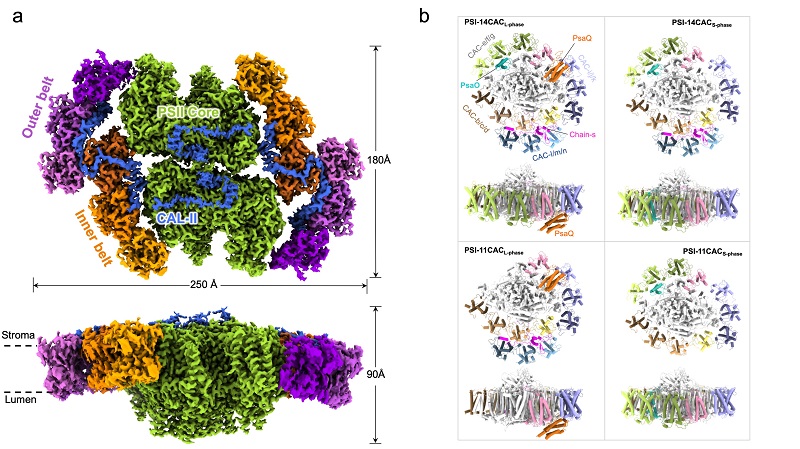Structures of photosystem-antenna complexes reveal the adaptation and regulation mechanisms of cryptophyte
Photosynthesis is one of the most important chemical reactions on Earth. Oxygenic phototrophs convert solar energy into chemical energy and release oxygen, thus sustaining nearly all life on our planet . Photosystem I (PSI) and photosystem II (PSII) are two membrane-embedded complexes critical for the light reactions of photosynthesis. Both photosystems are composed of a core complex and a peripheral antenna system. While the core complexes are well conserved, the light-harvesting antennae bound to the core vary greatly among different species, representing an adaptation mechanism to the specific ecological niches these phototrophs occupy.
Cryptophytes are a group of unicellular eukaryotic microalgae evolved from red algae via secondary endosymbiosis, and have peculiar antenna systems, which combine membrane-intrinsic chlorophyll a/c proteins (CACs) and membrane-extrinsic phycobiliproteins (PBPs). Analysis of the high-resolution structure of cryptophyte photosystem complexes will provide structural basis for the core-antenna assembly and the adaptation mechanisms of photosynthetic organisms .
On August 9, 2024, a research group led by Prof. LI Mei from the Institute of Biophysics, Chinese Academy of Sciences published a research paper entitled "Structural basis for the distinct core-antenna assembly of cryptophyte photosystem II" in Nature Communications.
The researchers solved a high-resolution structure of the PSII-CAC complex purified from cryptophyte cells in the stationary growth phase (Figure 1a). The structure shows that CACs are arranged as two arc-shaped belts that attach to the dimeric PSII core from one side in a non-parallel manner, which is distinct from the core-antenna organization of other photosynthetic organisms reported previously. A new core-antenna linker protein CAL-II was found to be crucial for the formation and stability of the PSII-CAC complex (Figure 1a). This study provides a structural basis for understanding the light energy utilization and adaptation mechanism of cryptophytes.
It is worth mentioning that on May 11, 2024, the same research group published a research paper entitled "Growth phase-dependent reorganization of cryptophyte photosystem I antennae" in Communications Biology, reporting the structural study of four PSI-CAC complexes purified from cryptophyte cells in different growth stages (logarithmic and stationary phases) (Figure 1b). This work reveals the presence of a novel PSI core subunit PsaQ, and the rearrangement mechanism of PsaQ and CACs at different growth phases of cryptophytes.

Figure 1. (a) Cryo-EM reconstructure of PSII-CAC complex. (b) Structures of four types of PSI-CAC complexes.
(Image by LI Mei's group)
Article link:
https://www.nature.com/articles/s41467-024-51206-y
https://www.nature.com/articles/s42003-024-06268-5
Contact: LI Mei
Institute of Biophysics, Chinese Academy of Sciences
Beijing 100101, China
Email: meili@ibp.ac.cn
(Report by Prof. LI Mei's group)

